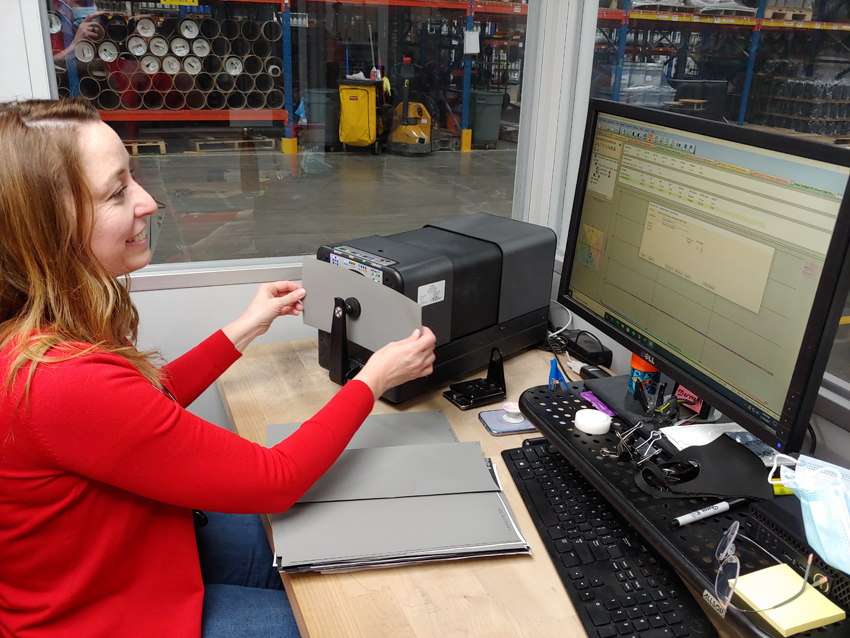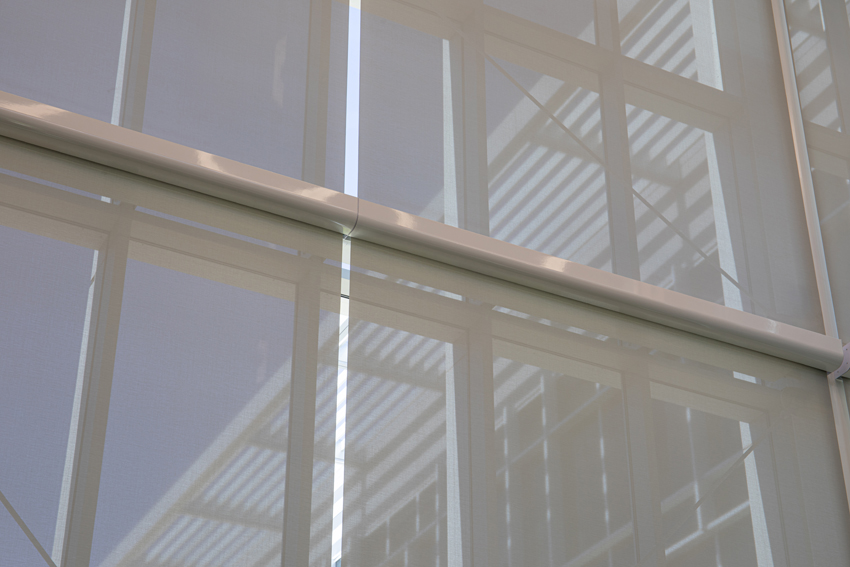Whole Building Approach to Interior Roller Shade Fabric Selections
Understanding Fenestration Data
Fenestration data is key information used to explain how a fabric will perform and is typically found on charts included on manufacturers’ swatch cards. Some key numbers to consider are encompassed in the RAT equation, which is an acronym for solar reflection, solar absorption, and solar transmission.
Total solar reflectance (Rs) is the percentage of solar energy directly reflected by the fabric. The higher this number, the more heat the fabric reflects back toward the window.
Total solar absorbance (As) is the percentage of solar energy absorbed by the shade fabric. The lower the number, the cooler it is near the window. This number will always be the opposite of the Rs, so if the Rs number is high, the As will be low, and vice versa.
Total solar transmittance (Ts) is the percentage of solar energy directly transmitted through the fabric. The higher the number, the more solar energy is being allowed through into the building. Taken together, the percentages of Rs, As, and Ts should add up to 100.
In addition to these RAT values, there are a number of other values associated with roller shade fabrics.
Visible light transmission (Tv) is the amount of visible light (in the range of 400–700 nanometers) that is directly transmitted through the fabric. This includes both direct and diffused light. The lower the value of the fabric, the greater its impact on controlling glare. Darker colors have a smaller number, which means they absorb more visible light, and this is why darker colors have better view-through characteristics.
Reflectance in the visible spectrum (Rv) is the percentage of visible light reflected by the fabric. Lighter colors will have a higher number, meaning they reflect more light and reduce glare. If too much visible light gets through the shade fabric, this creates glare. Darker colors block more visible light than light colors, reducing the amount of glare and allowing better view-through.
Reflectance in the infrared spectrum (Rs IR) is the percentage of solar energy in the infrared range reflected by the fabric. The IR spectrum is where heat is generated, so the higher the number, the cooler the surface of the shade fabric will be.
UV transmittance measures the percentage of ultraviolet (UV) energy directly transmitted through the fabric. A higher number means more UV light is getting through. In the long term, this can lead to fading of fabric-covered furnishings. This is inversely related to the openness of the fabric.
The solar heat gain coefficient (SHGC) number is the complex glazing value taking the glass and shade fabric into account. Dual-pane glass with an SHGC of 0.20 or greater is usually specified for new installations. This means that 80 percent of the sun’s heat energy is prevented from entering the space.
Different weavers use different standards to evaluate their fabrics and verify their specifications. Starting with ASTM E903: Standard Test Method for Solar Absorptance, Reflectance, and Transmittance of Materials Using Integrating Spheres, the Rs, As, Ts, Rv, Tv, and Rs IR are all measured with a spectrophotometer.
Another standard is ASTM E891: Tables for Terrestrial Direct Normal Solar Spectral Irradiance Tables for Air Mass. This covers the calculations for the values Rs, As, Ts, Rv, Tv, and Rs IR. ASTM E891 replaced an older standard, ASTM G173, but the reference tables remain the same.
ASHRAE Standard 74: Method of Measuring Solar-Optical Properties of Materials is a well-known method of using a pyranometer to measure and calculate the fenestration properties of sunlight.

Photo courtesy of Mermet USA
Different weavers use different standards to evaluate fabrics and verify their specifications. Performance specifications of shade fabrics are measured using tools such as spectrophotometers and pyranometers. Total solar reflectance, total solar absorbance, and total solar transmittance are among the measurements taken.
Complex Glazing
To optimize roller shade fabric specifications, a complex glazing approach considers how the fabric performs along with the glass as a total system. Similarly, an integrated, whole building approach evaluates the building’s facade, surroundings, geographical location, orientation, lighting requirements, and how the space will be used.
“From a whole building perspective, architects should select the shade’s openness value, visible transmittance, and fabric reflectance that provides protection from glare, visual comfort, daylighting performance, allows some view to the outside, and aesthetically matches with the rest of the building facade,” Tzempelikos says.
For example, while roller shade specifications typically come after the glazing and facade design, Tzempelikos advises that the properties and control of glazing and shading systems be designed together so that their combined impact on occupant comfort and energy use can be assessed in a holistic, integrated way. “Shading properties like angular transmittance and reflectance add and interact with the effects of glazing properties, such as SHGC and the overall angular thermal and light transmittance of the window system.”
Along these lines, Angie Lee, AIA, IIDA, interiors, FX Collaborative, New York, recommends having a sample of the exterior glazing in hand when selecting the shade fabric. She explains that the color rendition and intensity of light coming through the glass can significantly alter the color of the shade. While there is a slightly smaller range of noticeable color variations from the exterior, once the level of tonal saturation has been selected, the impact of the glass specifications is more noticeable on the interior. At the same time, as previously noted, darker shade colors are much more forgiving in the rendering of natural light transmitted through the glass.
Angarano agrees that different glazing colors (i.e., clear, green, blue, gray, etc.) will impact the appearance of the shades from the exterior. Further, the exterior side of the shade should complement or match the exterior facade and how the glazing appears at different times during the day.
Describing windows as representing a spatial recess or expansion that connects the interior to views, natural light, and the greater world outside, Lee cautions against selecting shades that detract from this. “In the past, shade fabric was always white and resulted in a plasticky aesthetic that diminished the positive effects of having a window,” she explains. “Interior design principles have thankfully steered the coloration of the shades to mimic the darker or more saturated tones of an exterior landscape, sky, or cityscape.”
Expounding upon this point, Lee adds, “The shade fabric will enhance and complement the exterior, or it will become the unintentional feature that can render a carefully constructed building wall as chaotic instead of curated. The width, color, texture, and alignments of the shade system are integral to the design intent being evident from the exterior view.”
In a similar vein, Robert H. Adams, associate principal at Amenta Emma Architects in Hartford, Conn., points out that the shading material plays a major role in the building facade. “Stand in any city and look around. Those beautiful facades that architects and designers labored over are now a mishmash of shades—some up, some down, some halfway, etc.”
Andow adds the following observation: “Let’s face it: There is a common story where the exterior aesthetic of a thoughtfully designed curtain wall facade is ultimately marred by a disorganized patchwork of manual roller shades positioned at various heights that are left drawn for days or weeks. It is never captured in renderings, but it is a defining characteristic of the aesthetic of all glass buildings.”
To help mitigate this, Adams advises against shades that are denser and brighter in color and instead selecting darker, more porous shade materials that tend to disappear from the outside, thereby enabling the exterior to present as intended.
On a recent historical preservation project in Hartford, Adams’s team had initially decided upon a light-colored shade material, but then realized that the color would appear to infill the punched openings in the 1931 limestone building and therefore detract from the neoclassical facade. “Instead, we used a darker shade material that is hardly visible from the exterior and preserves the facade of this historical building.”
Motorization and automation can also be used to ensure shade fabric panels are properly deployed throughout the day.
EYP's Lead Interior Designer and Interior Design National Group Leader Roseann Pisklak, NCIDQ, AAHID, LEED AP, EDAC, brings up another interesting point, noting that at lower levels, pedestrian movement and vehicular traffic may be distracting, negatively impacting worker performance on those floors. Consequently, in addition to the aesthetics, the practical consideration of productivity can also impact product selections for the lower part of the building.

Photo: Matt Oberer, MattO Photo
To optimize roller shade fabric specifications, a complex glazing approach considers how the fabric performs along with the glass as a total system, as shown here at the University of New Mexico Physics and Astronomy Building.










